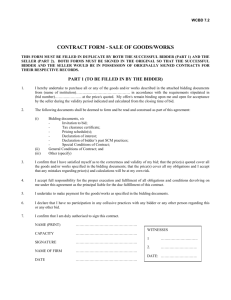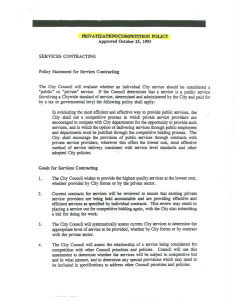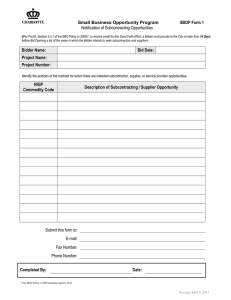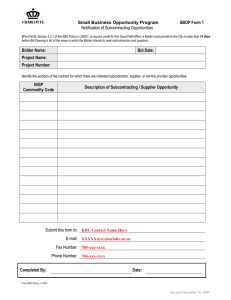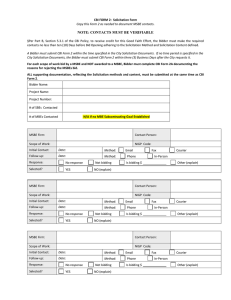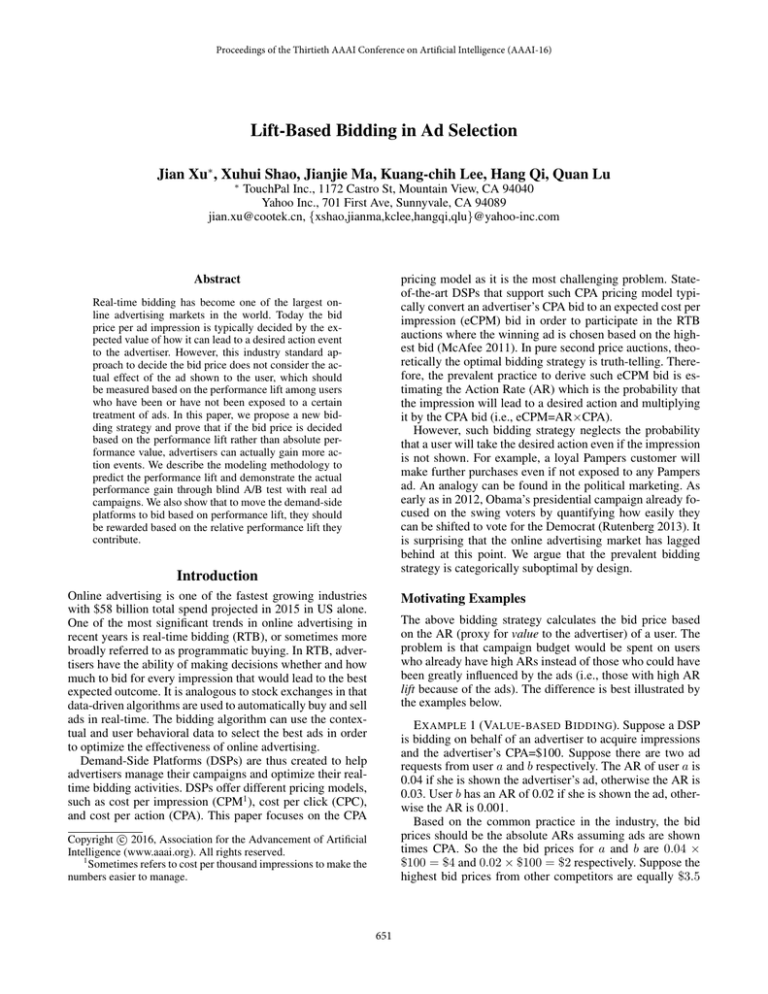
Proceedings of the Thirtieth AAAI Conference on Artificial Intelligence (AAAI-16)
Lift-Based Bidding in Ad Selection
Jian Xu∗ , Xuhui Shao, Jianjie Ma, Kuang-chih Lee, Hang Qi, Quan Lu
∗
TouchPal Inc., 1172 Castro St, Mountain View, CA 94040
Yahoo Inc., 701 First Ave, Sunnyvale, CA 94089
jian.xu@cootek.cn, {xshao,jianma,kclee,hangqi,qlu}@yahoo-inc.com
pricing model as it is the most challenging problem. Stateof-the-art DSPs that support such CPA pricing model typically convert an advertiser’s CPA bid to an expected cost per
impression (eCPM) bid in order to participate in the RTB
auctions where the winning ad is chosen based on the highest bid (McAfee 2011). In pure second price auctions, theoretically the optimal bidding strategy is truth-telling. Therefore, the prevalent practice to derive such eCPM bid is estimating the Action Rate (AR) which is the probability that
the impression will lead to a desired action and multiplying
it by the CPA bid (i.e., eCPM=AR×CPA).
However, such bidding strategy neglects the probability
that a user will take the desired action even if the impression
is not shown. For example, a loyal Pampers customer will
make further purchases even if not exposed to any Pampers
ad. An analogy can be found in the political marketing. As
early as in 2012, Obama’s presidential campaign already focused on the swing voters by quantifying how easily they
can be shifted to vote for the Democrat (Rutenberg 2013). It
is surprising that the online advertising market has lagged
behind at this point. We argue that the prevalent bidding
strategy is categorically suboptimal by design.
Abstract
Real-time bidding has become one of the largest online advertising markets in the world. Today the bid
price per ad impression is typically decided by the expected value of how it can lead to a desired action event
to the advertiser. However, this industry standard approach to decide the bid price does not consider the actual effect of the ad shown to the user, which should
be measured based on the performance lift among users
who have been or have not been exposed to a certain
treatment of ads. In this paper, we propose a new bidding strategy and prove that if the bid price is decided
based on the performance lift rather than absolute performance value, advertisers can actually gain more action events. We describe the modeling methodology to
predict the performance lift and demonstrate the actual
performance gain through blind A/B test with real ad
campaigns. We also show that to move the demand-side
platforms to bid based on performance lift, they should
be rewarded based on the relative performance lift they
contribute.
Introduction
Online advertising is one of the fastest growing industries
with $58 billion total spend projected in 2015 in US alone.
One of the most significant trends in online advertising in
recent years is real-time bidding (RTB), or sometimes more
broadly referred to as programmatic buying. In RTB, advertisers have the ability of making decisions whether and how
much to bid for every impression that would lead to the best
expected outcome. It is analogous to stock exchanges in that
data-driven algorithms are used to automatically buy and sell
ads in real-time. The bidding algorithm can use the contextual and user behavioral data to select the best ads in order
to optimize the effectiveness of online advertising.
Demand-Side Platforms (DSPs) are thus created to help
advertisers manage their campaigns and optimize their realtime bidding activities. DSPs offer different pricing models,
such as cost per impression (CPM1 ), cost per click (CPC),
and cost per action (CPA). This paper focuses on the CPA
Motivating Examples
The above bidding strategy calculates the bid price based
on the AR (proxy for value to the advertiser) of a user. The
problem is that campaign budget would be spent on users
who already have high ARs instead of those who could have
been greatly influenced by the ads (i.e., those with high AR
lift because of the ads). The difference is best illustrated by
the examples below.
E XAMPLE 1 (VALUE - BASED B IDDING). Suppose a DSP
is bidding on behalf of an advertiser to acquire impressions
and the advertiser’s CPA=$100. Suppose there are two ad
requests from user a and b respectively. The AR of user a is
0.04 if she is shown the advertiser’s ad, otherwise the AR is
0.03. User b has an AR of 0.02 if she is shown the ad, otherwise the AR is 0.001.
Based on the common practice in the industry, the bid
prices should be the absolute ARs assuming ads are shown
times CPA. So the the bid prices for a and b are 0.04 ×
$100 = $4 and 0.02 × $100 = $2 respectively. Suppose the
highest bid prices from other competitors are equally $3.5
c 2016, Association for the Advancement of Artificial
Copyright Intelligence (www.aaai.org). All rights reserved.
1
Sometimes refers to cost per thousand impressions to make the
numbers easier to manage.
651
for both a and b, which means the advertiser will win the
auction for a while lose the auction for b. In this case, the
expected total number of actions the advertiser can have is
0.04 + 0.001 = 0.041, and the inventory cost of the DSP is
$3.5. Since advertiser only pays for impressions that lead to
actions, the expected revenue of the DSP is $4.
AR. We denote by p the AR, Δp the AR lift, and p − Δp the
background AR if no further specification is made.
The common practice in the industry is to bid CPA×p.
We generalize this practice and define value-based bidding
as follows:
D EFINITION 2 (VALUE -BASED B IDDING). Let p be the
AR of a user if the advertiser’s ad is shown, value-based
bidding places a bid price of α × p to acquire an impression
from this user for the advertiser, where α > 0.
E XAMPLE 2 (L IFT- BASED B IDDING). Let us continue
with Example 1. It is not difficult to see that user b should
be more preferable to the advertiser because the advertiser
could expect a more significant AR lift from her (the AR lift
of a is 0.04 − 0.03 = 0.01 while b is 0.02 − 0.001 = 0.019).
If the bid prices the DSP places on a and b are proportional to the AR lifts, for instance $2 and $3.8, then the advertiser will win the auction for b instead of a. In this case,
the expected total number of actions the advertiser can have
is 0.03 + 0.02 = 0.05 - better than that in Example 1. The
inventory cost of the DSP is also $3.5, but the expected revenue of the DSP becomes $2 because the advertiser only
pays for impressions that lead to actions. It results in a negative profit to the DSP.
However, examples in the Introduction section show that
such bidding strategy does not necessarily optimize the overall campaign performance for the advertiser. As we advocate
for focusing on the AR lift instead of absolute AR, we propose the concept of lift-based bidding in which the bid price
is proportional to the AR lift.
D EFINITION 3 (L IFT-BASED B IDDING). Let Δp be the
AR lift of a user if the advertiser’s ad is shown, lift-based
bidding places a bid price of β×Δp to acquire an impression
from this user for the advertiser, where β > 0.
The above toy examples show that the advertiser eventually gets more actions when bid based on AR lift than
based on absolute AR. In addition, they also show that the
advertiser’s marketing objective to maximize actions is not
aligned with the DSP’s interest.
In the CPA pricing model, a DSP is rewarded based on
the number of actions attributed to it. Advertisers finally pay
DSPs based on the amount of actions attributed to them. The
industry standard attribution model is last-touch attribution.
D EFINITION 4 (L AST-T OUCH ATTRIBUTION). An advertiser attributes the full credit of an observed user action
to the DSP which delivered the last relevant ad impression
to the user.
Our Contribution
In this paper, we advocate for an industry-wide transition
from value-based bidding to lift-based bidding. That is, the
bid price should be based on the AR lift instead of the absolute AR. Our contributions can be summarized as follows:
• We describe a simple yet effective modeling methodology
to predict AR lift. Online A/B test with real ad campaigns
backed up our concepts and techniques.
Suppose there are two DSPs DSP1 and DSP2 bidding on
behalf of the same advertiser at the same time. DSP1 practices value-based bidding while DSP2 executes lift-based
bidding. Let ui be the user of the i-th ad request, pi be the
AR if the advertiser’s ad is shown to ui , and Δpi be the AR
lift because of the ad impression. To simplify the discussion,
let us assume every ad request is from a different user and
there are no additional candidates in the auctions. In an ad
exchange marketplace with pure second-price auction, we
have
• We point out that the advertiser’s marketing objective is
not aligned with the DSP’s interest. To move the DSPs to
lift-based bidding, they should be rewarded based on the
relative performance lift they contribute.
L EMMA 1. DSP1 wins the auction for ui at the cost of
β × Δpi if α × pi > β × Δpi ; DSP2 wins the auction for
ui at the cost of α × pi if α × pi < β × Δpi .
Value-Based Bidding vs. Lift-Based Bidding
T HEOREM 1. With the last-touch attribution model,
DSP2 yields more actions than DSP1 for the advertiser
when the advertiser attributes the same amount of actions
to them 2 .
• We propose the concept of lift-based bidding, which we
prove both mathematically and empirically to be a better bidding strategy than value-based bidding in terms of
maximizing advertiser benefits.
In this section, we prove that lift-based bidding is a better
strategy than value-based bidding in terms of maximizing
advertiser benefits. However, it would be opposed by DSPs
under the industry-standard last-touch attribution model.
Proof. Let i be the index of all the users, j be the index
of those users that DSP1 wins (i.e., α × pj > β × Δpj ),
and k be the index of those users that DSP2 wins (i.e.,
α × pk < β × Δpk ). It is straightforward to see that the
D EFINITION 1 (AR, BACKGROUND AR, AND AR L IFT).
Given an ad request q from a user u and an advertiser A, we
define AR w.r.t. (q, u, A) as the probability that u will take
the desired action defined by A after the ad of A is served
to q, background AR w.r.t. (q, u, A) as the probability that
u will take the desired action if the ad of A is not served to
q, and AR lift as the difference between AR and background
The condition of DSP1 and DSP2 getting equal attributions
from the advertiser is an important setup to illustrate that DSP2
will in fact produce relatively more actions for the advertiser. This
setup condition can be achieved by adjusting the winning landscape
through the parameters of α and β
2
652
expected number
of actions
to be attributed to DSP1 and
DSP2 are
p
and
j j
k pk respectively. The expected
number of actions if only DSP1 is considered can be decomposed as two parts: sum of the ARs of users that DSP1
wins, and sum of thebackground
ARs of users that DSP1
loses. So it becomes j pj + k (pk − Δpk ). Similarly, the
expected
number of
actions if only DSP2 is considered is
j (pj − Δpj ) +
k pk .
Therefore, let A1 (A2 ) be the expected number of actions
per attributed action if only DSP1 (DSP2 ) is considered,
we have
(pk − Δpk )
j pj +
k
(1)
A1 =
j pj
j (pj − Δpj ) +
k pk
(2)
A2 =
k pk
between attribution models and bidding strategies. We show
that to move the DSPs from value-based bidding to lift-based
bidding, they should be rewarded based on the relative action
lift they contributed to the final actions.
Lift-Based Bidding in Action
Predicting AR Lift
To implement lift-based bidding, it is important to estimate
the AR lift. One may think of building a machine learning
model to predict the lift directly. However, since the real ad
serving logs contain only instances that an ad is either shown
or not shown, it is theoretically impossible to have the true
AR lift data for modeling. Therefore, in order to predict the
AR lift, we strive to estimate both the ARs assuming the ad
is shown or not shown respectively.
Formally, let a be an ad, s be the state of a user at ad
request time, and s+ (a) be the state of the user if a is shown.
Conceptually, s consists of the user’s demographic status,
timestamped past events including page views, searches, ad
views/clicks, and anything that describes the user state at ad
request time. The only difference between s and s+ (a) is the
ad impression of a. Let p(action|s) be the AR of the user if
a is not shown and p(action|s+ (a)) be the AR if a is shown,
the AR lift is
When the same
of actions is attributed to DSP1
amount
and DSP2 (i.e., j pj = k pk ), by swapping the denominators and consolidating the numerators in Equation 1 and
2, noticing α × pj > β × Δpj and α × pk < β × Δpk , we
have
pi −
Δpk
pi
α
(3)
< i
−
A1 = i k
p
p
β
k k
k k
pi
α
i pi −
j Δpj
(4)
> i −
A2 =
β
j pj
j pj
Since j pj = k pk , it is obvious that A1 < A2 .
Δp = p(action|s+ (a)) − p(action|s)
Considering a specific ad request instance in the ad serving log, the ad was either shown or not shown. Therefore, either case will be absent in the modeling data. We address this
challenge by establishing a model that has sufficient generalization capability. More specifically, we use a function F
to map a state to a set of features shared among different instances. Then a single and generic AR prediction model P̂
is built upon the derived feature set and the AR lift can be
estimated as
= P̂ (action|F (s+ (a))) − P̂ (action|F (s)) (8)
Δp
T HEOREM 2. With the last-touch attribution model,
DSP2 costs more than DSP1 when the advertiser attributes
the same amount of actions to them.
Proof. Again, let i be the index of all the users, j be the user
index such that α × pj > β × Δpj , and k be the user index
such that α×pk < β×Δpk . The expected
number of actions
to be attributed to DSP1 and DSP2 are j pj and k pk
respectively. The cost of DSP1 and DSP2 are j β × Δpj
and k α × pk respectively. Therefore let C1 and C2 be the
cost per attributed action of DSP1 and DSP2 respectively,
we have
j β × Δpj
(5)
C1 =
j pj
k α × pk
C2 = (6)
k pk
Noticing α × pj > β × Δpj , we have C1 < β ×
It is apparent that C2 = α. Therefore C1 < C2 .
α
β
(7)
The difference between F (s+ (a)) and F (s) is reflected
by different feature values induced from a. At ad serving
time when Δp is to be estimated, if for instance we consider
impression frequency of a as a feature, the feature value in
F (s+ (a)) should be greater than that in F (s) by one.
Model Training
Our task is to train a generic AR prediction model P̂ to give
AR estimations for both cases when an ad is shown or not
shown. Existing AR prediction models in the literature are
trained based on the post-view (Lee et al. 2012) or postclick (Rosales, Cheng, and Manavoglu 2012) actions. That
is, the training samples are collected from only those impression events or click events. For example, in post-view action
modeling, each impression event will trigger a training sample which is labeled as positive if there is an action followed.
However, such methodology is not preferred in our scenario
for several reasons.
First, since the training samples from only impression or
click events are not representative to those cases when the
ad is not shown, models trained upon these samples are
= α.
We have shown that lift-based bidding benefits the advertisers but the higher cost per attributed action may undermine the interests of the DSPs. The root cause of this
conflict is that the industry-standard attribution model does
not attribute actions fairly to the DSPs. Researchers have
pointed out that an action should be attributed to multiple
touch points in a data driven fashion (Shao and Li 2011) or
based on causal lift (Dalessandro et al. 2012b). In the Attribution and Bidding section, we discuss the relationship
653
Percentage of actions covered (%)
100
Source
Behaviors
impression
click
80
60
40
Demographics
20
Mobile
0
0
50
100
150
200
250
300
350
lookback window size (hours)
Figure 1: Less than 10% of the reported actions have precedent ad impressions from the same advertiser within the
lookback window. Training samples generated from only
impression and/or click events miss a large portion of the
informative actions.
Feature name
IMP FREQ ADV
IMP RNCY ADV
CLK FREQ ADV
CLK RNCY ADV
PV FREQ TOPIC
PV RNCY TOPIC
SRCH FREQ TOPIC
SRCH RNCY TOPIC
AGE GROUP
GENDER
GEO AREA
INST FREQ APP
INST RNCY APP
USE FREQ APP
USE RNCY APP
Note
Impression and click frequency/recency from each
advertiser. Page-view and
search frequency/recency of
each topic (pages and search
queries are segmented into
several semantic topics.)
Ages are mapped into several age groups. User’s geographic location is at some
moderate resolution level.
Installation and usage frequency/recency of each mobile app.
Table 1: Features generated for AR modeling.
request details such as geo-location, web page or mobile app
being visited are folded in these features so that the run-time
context can also be leveraged for prediction. For example, if
the recency of visiting Yahoo! homepage is a feature, an ad
request from Yahoo! homepage will set this feature value as
“most recent”.
The sample generation terminates when all the action
events have been involved or the positive samples are sufficient. Once the training samples are gathered, we train a
Gradient-Boosting-Decision-Tree (GBDT) model to predict
the rank order and then calibrate using isotonic regression to
translate a GBDT score to an AR. Please note that we utilize
our in-house GBDT tool with distributed training capability
for modeling; however, other proper machine learning models can also be applied.
not generalized enough to predict p(action|s). Second, even
for predicting p(action|s+ (a)), leveraging training samples
from only impression or click events still suffers from survival bias. In the RTB marketplace, impressions are purchased through public auctions. Therefore, impressions and
clicks are available from only those winning auctions. Such
survival bias is prevalent in click modeling. In action modeling, it could be avoided because actions can happen even
there was no impression showed. Third, our observation
from real ad campaigns shows that for the majority (usually
>90%) of actions, we have not shown any ad of the advertiser before3 . In other words, if training samples are only
generated from impression or click events, the majority of
actions (positive samples) are not leveraged for modeling.
Therefore, we take a different approach that we train the
AR prediction model upon the whole population. Training
samples are generated from every user’s timeline instead of
from merely impression/click events. To mimic the true action distribution, we first randomly select a user u weighted
by its ad request frequency. Then a random timestamp ts is
chosen on u’s timeline and a training sample is generated
based on u and ts. If u has at least one action in the action
window (denoted by (ts, ts + aw]), the sample is labeled as
positive and otherwise negative, where aw is the action window size as long as several hours to several days based on
business definitions. Then features are generated within the
feature window (denoted by (ts − f w, ts]), where f w is the
feature window size.
Raw input variables for feature generation include user
historical profile within the feature window with such as
page views, ad impressions, clicks, searches and mobile app
based events. Each user event is used as a point-in-time to
generate features. Table 1 is a list of different types of features we generated for AR prediction. At serving time, ad
Fitting Lift-Based Bidding in the Market
Conventional value-based bidding calculates the bid price
by multiplying predicted absolute AR by advertiser CPA. In
lift-based bidding, it is not proper to simply multiply AR
lift by the same advertiser CPA. Otherwise one can seldom
win any auction if the majority of the other competitor DSPs
are still practicing value-based bidding. Recall that in liftbased bidding the bid price is proportional to the AR lift i.e.,
β × Δp. Our selection of β is
p
β=
× CPA
(9)
Δp
where p is the population mean of AR and Δp is the population mean of AR lift. The idea is straightforward: if the
advertiser is willing to pay CPA for each action in the conventional way, then each incremental action should be paid
p
×CPA if only incremental actions need to
at the price of Δp
get paid.
Blind A/B Test with a Real DSP
3
To empirically prove our proposed concepts, we set up A/B
test experiments on Yahoo’s Demand-Side Platform. We first
Advertisers usually report actions via action pixels placed on
their websites or apps. Therefore DSPs can have the full action set.
654
randomly split users into three equal-sized groups. Then we
created three bidders: a passive bidder which always places
a zero bid, a value-based bidder, and a lift-based bidder. We
selected five advertisers to participate in the test. To be fair,
each advertiser’s budget was evenly split and assigned to the
value-based bidder and lift-based bidder respectively (the
passive bidder would not spend any budget). Each advertiser’s campaign ran for one week and their budgets were
all spent out which means value-based bidder and lift-based
bidder spent the same amount of budget. We counted the
number of actions4 observed in each group in a three weeks
window from the campaign start date. The results shown in
Table 2, 3, 4 and 5 backed up our claims and methods.
First, by comparing passive bidder and value-based bidder
(Table 2), it is easy to demonstrate that a user may take actions even if no impression is shown. Although showing ads
to users did help lift the action yield, the number of actions
when no ad is shown is already significant. This is not surprising because advertisers typically run campaigns through
multiple channels such as TV, magazine, internet, etc simultaneously. Even if a user is not shown any display ad by our
DSP, she can still be influenced by other touch points. This
is exactly why lift-based bidding is more preferable since it
tries to maximize the effectiveness of display ads by taking
background AR into account. Table 3 shows the comparison
between passive bidder and lift-based bidder.
Second, from advertiser’s perspective, lift-based bidder
generated more actions than value-based bidder with the
same amount of budget. This result is observed consistently among all the five advertisers (Table 4). Since the
background actions prevalently exist, a fairer comparison
should be comparing their action lifts over background actions, which we call lift-over-lift. Take Advertiser 1 for example, value-based bidder generated 11.2% more actions
than the background actions while lift-based bidder yielded
28.7% more. In this case the lift-over-lift measure is (28.7 −
11.2)/11.2 = 156%. Lift-based bidding dramatically increases the incremental actions compared to value-based
bidding so the lift-over-lift measure is very significant.
Third, from DSP’s perspective, lift-based bidder resulted
in more inventory cost than value-based bidder when the
same number of actions were attributed to them. Recall that
advertiser only pays for each attributed action at the price of
CPA and the two bidders spent the same amount of budget.
So the number of attributions are the same. From Table 5 we
observe the inventory cost of lift-based bidder is consistently
higher than that of value-based bidder.
Lastly and interestingly, we have observed increased
number of impressions when comparing lift-based bidding
to value-based bidding. Even though the overall inventory
cost is higher, the effective cost per impression is lower for
lift-based bidder than value-based bidder. The lift-based bidder does not always compete with other bidders for those
high AR users. Instead, it tries to acquire users who are more
likely to be influenced. Therefore it has the advantage of
avoiding competition and acquiring more impressions at a
lower cost per impression.
The above results backed up our concepts and techniques.
Since the lift-based bidder took the risk of higher cost while
as we have seen it actually benefited the advertisers, advertisers should think of a more reasonable attribution model to
align the DSPs’ benefits with their marketing objectives.
Attribution and Bidding
We have proved that DSPs may be opposed to lift-based bidding because of higher cost per attributed action. The root
cause is that they are not rewarded based on the action lift
they contribute. Therefore they do not have the incentive to
bid to maximize total actions. Actually, a rational DSP will
always bid at the price
eCPM = AR × CPA × p(attribution|action)
(10)
where p(attribution|action) is the probability it gets attributed if an action happens. The industry common practice
to bid AR×CPA is simplifying this by assuming that the full
credit of an action will be eventually attributed to the DSP. In
many scenarios, such assumption is true. However, we must
point out that such assumption is not always valid especially
when multiple DSPs are running campaigns for the same advertiser simultaneously.
Given that the DSPs will always bid a rational eCPM
price, we are more interested in how advertisers can move
them to lift-based bidding, which we have shown can bring
more actions to the advertisers. Intuitively, if the DSPs are
attributed based on the relative AR lift they contribute to the
final AR, they have more incentive to practice lift-based bidding. Therefore the key is the attribution model.
Again, let ui be the user of the i-th ad request, pi be the
AR if the advertiser’s ad is shown to ui , and Δpi be the AR
lift. Let ai = p(attribution|action, ui ) be the probability
that the action from ui is attributed to the DSP that wins ui .
Suppose there are two DSPs DSP1 and DSP2 bidding on
behalf of the same advertiser at the same time. DSP1 always bid the rational price (i.e., CPA × pi × ai ) while DSP2
practices lift-based bidding (i.e., bid β × Δpi ).
i
T HEOREM 3. Unless ai = CPβ A × Δp
pi (i.e., DSP1 always
bid the same price as DSP2 ), DSP2 yields more actions
than DSP1 for the advertiser when the advertiser attributes
the same amount of actions to them.
Proof. Let i be the index of all the users, j be the index of
those users that DSP1 wins (i.e., CPA × pj × aj > β ×
Δpj ), and k be the index of those users that DSP2 wins
(i.e., CPA × pk × ak < β × Δpk ). It is straightforward to see
that the expected
number of actions
to be attributed to DSP1
and DSP2 are j pj ×aj and k pk ×ak respectively. The
expected
number of actions if only DSP1 is considered is
p
+
expected number of actions
j
j
k (pk −Δpk ), and the
if only DSP2 is considered is j (pj − Δpj ) + k pk .
Therefore, let A1 (A2 ) be the expected number of actions
per attributed action if only DSP1 (DSP2 ) is considered,
4
Action pixel fires to be more accurate. Even in the passive
group, there can still be actions reported via action pixel fires on
advertiser’s website or app.
655
passive bidder
# imps # actions
0
642
0
823
0
1,438
0
1892
0
5,610
Adv
1
2
3
4
5
Value-based bidder
# imps
# actions
53,396
714
298,333
896
11,048,583
1,477
3,915,792
2,016
6,015,322
6,708
Incremental action
Action lift
72
73
39
124
1,098
11.2%
8.9%
2.7%
6.6%
19.6%
Table 2: Blind A/B test on five pilot advertisers - Value-based bidder v.s. Passive bidder.
passive bidder
# imps # actions
0
642
0
823
0
1,438
0
1892
0
5,610
Adv
1
2
3
4
5
Lift-based bidder
# imps
# actions
59,703
826
431,637
980
11,483,360
1509
4,368,441
2,471
8,770,935
8,291
Incremental action
Action lift
184
157
71
579
2,681
28.7%
19.1%
4.9%
30.6%
47.8%
Table 3: Blind A/B test on five pilot advertisers - Lift-based bidder v.s. Passive bidder.
Adv
1
2
3
4
5
Value-based bidder
Action lift
# actions
(vs. passive)
53,396
714
11.2%
298,333
896
8.9%
11,048,583
1,477
2.7%
3,915,792
2,016
6.6%
6,015,322
6,708
19.6%
# imps
Lift-based bidder
Action lift
# actions
(vs. passive)
59,703
826
28.7%
431,637
980
19.1%
11,483,360
1509
4.9%
4,368,441
2,471
30.6%
8,770,935
8,291
47.8%
# imps
Action lift
Lift-over-lift
13.6%
9.4%
2.2%
22.6%
23.6%
156%
115%
82%
367%
144%
Table 4: Lift-based bidding vs. Value-based bidding - Advertiser’s perspective. “Action lift” is the absolute # actions difference
between lift-based bidder and value-based bidder. “Lift-over-lift” is comparing the their action lifts over passive bidder.
Adv
1
2
3
4
5
Value-based bidder
# imps
# attrs Inventory cost
53,396
50
$278.73
298,333
80
$1,065.05
11,048,583
240
$25,522.22
3,915,792
200
$10,846.74
6,015,322
500
$19,296.51
Lift-based bidder
# imps
# attrs Inventory cost
59,703
50
$300.31
431,637
80
$1,467.57
11,483,360
240
$25,837.56
4,368,441
200
$11,183.21
8,770,935
500
$23,501.90
Inventorycost diff
7.7%
37.8%
1.2%
3.1%
21.8%
Cost-perimp diff
-3.6%
-4.8%
-2.6%
-7.6%
-16.5%
Table 5: Lift-based bidding vs. Value-based bidding - DSP’s perspective. Both bidders spent out equal amount of assigned
budget, so the # attributions are always the same. Cost-per-impression is the inventory cost averaged by # impressions.
we have
A1 =
j
pj +
j
k (pk
− Δpk )
pj × a j
Therefore A1 < A2 unless DSP1 always bid the same
i
price as DSP2 i.e., ai = CPβ A × Δp
pi .
(11)
− Δpj ) + k pk
A2 =
(12)
k pk × a k
If DSP1 and DSP2 are not always bidding the same
price, we can always adjust β to control the winning landscape so that DP S1 and DSP2 get the same amount of attribution. When the same
is attributed to
amount of actions
DSP1 and DSP2 (i.e., j pj ×aj = k pk ×ak ), by swapping the denominators and consolidating the numerators in
Equation 1 and 2, noticing CPA × pj × aj > β × Δpj and
CPA × pk × ak < β × Δpk , we have
pi − k Δpk
CPA
i
i pi
A1 =
(13)
<
−
p
×
a
p
×
a
β
k
k
k k
k k
pi
CPA
i pi −
j Δpj
A2 =
(14)
> i
−
p
×
a
p
×
a
β
j
j
j j
j j
i
T HEOREM 4. Unless ai = CPβ A × Δp
pi (i.e., DSP1 always
bid the same price as DSP2 ), DSP2 costs more than DSP1
when the advertiser attributes the same amount of actions to
them.
j (pj
Proof. The expected number
of actionsto be attributed to
DSP1 and DSP2 are j pj × aj and k pk × ak respec
tively. The cost of DSP1 and DSP2 are j β × Δpj and
k CPA × pk × ak respectively. Therefore let C1 and C2
be the cost per attributed action of DSP1 and DSP2 respectively, we have
j β × Δpj
(15)
C1 = j pj × a j
CPA × pk × ak
C2 = k (16)
k pk × a k
656
Noticing CPA × pj × aj > β × Δpj , we have C1 < CPA.
Since C2 = CPA, C1 < C2 unless DSP1 always place the
i
same bid as DSP2 , i.e., ai = CPβ A × Δp
pi .
models and technologies can be implemented in the industry where multiple parties such as advertisers, DSPs, ad exchanges, and third-party verification companies are all involved.
Theorem 3 and 4 suggest that for a rational DSP, the only
way to move it to lift-based bidding is to attribute based on
the relative lift it contributes to the final action (i.e., ai ∝
Δpi
pi ). We believe by directly paying for the performance lift,
the advertisers can move the DSPs to the more optimized
bidding strategy.
References
Chapelle, O. 2014. Modeling delayed feedback in display
advertising. In Proceedings of the 20th ACM SIGKDD international conference on Knowledge discovery and data mining, 1097–1105. ACM.
Dalessandro, B.; Hook, R.; Perlich, C.; and Provost, F.
2012a. Evaluating and optimizing online advertising: Forget the click, but there are good proxies.
Dalessandro, B.; Perlich, C.; Stitelman, O.; and Provost, F.
2012b. Causally motivated attribution for online advertising.
In Proceedings of the Sixth International Workshop on Data
Mining for Online Advertising and Internet Economy, 7.
ACM.
Geyik, S. C.; Saxena, A.; and Dasdan, A. 2014. Multi-touch
attribution based budget allocation in online advertising. In
Proceedings of 20th ACM SIGKDD Conference on Knowledge Discovery and Data Mining, 1–9. ACM.
Lee, K.-C.; Orten, B.; Dasdan, A.; and Li, W. 2012. Estimating conversion rate in display advertising from past performance data. ACM SIGKDD Conf. on Knowledge Discovery
and Data Mining.
McAfee, R. P. 2011. The design of advertising exchanges.
Review of Industrial Organization 39(3):169–185.
Perlich, C.; Dalessandro, B.; Hook, R.; Stitelman, O.;
Raeder, T.; and Provost, F. 2012. Bid optimizing and inventory scoring in targeted online advertising. In Proceedings of the 18th ACM SIGKDD international conference on
Knowledge discovery and data mining, 804–812. ACM.
Rosales, R.; Cheng, H.; and Manavoglu, E. 2012. Postclick conversion modeling and analysis for non-guaranteed
delivery display advertising. In Proceedings of the fifth ACM
international conference on Web search and data mining,
293–302. ACM.
Rutenberg, J. 2013. Data you can believe in. New York
Times Magazine 22–29.
Shao, X., and Li, L. 2011. Data-driven multi-touch attribution models. In Proceedings of the 17th ACM SIGKDD
international conference on Knowledge discovery and data
mining, 258–264. ACM.
Wooff, D. A., and Anderson, J. M. 2014. Time-weighted
multi-touch attribution and channel relevance in the customer journey to online purchase. Journal of Statistical Theory and Practice (ahead-of-print):1–23.
Zhang, W.; Yuan, S.; and Wang, J. 2014. Optimal realtime bidding for display advertising. In Proceedings of the
20th ACM SIGKDD international conference on Knowledge
discovery and data mining, 1077–1086. ACM.
Related work
Predicting AR for display ad has attracted much research
interest. Most existing works towards this goal model actions and clicks within the same framework (Lee et al. 2012;
Rosales, Cheng, and Manavoglu 2012; Chapelle 2014). We
notice that none of these existing works explicitly models AR lift. Although researchers are exploring alternative
bidding strategies in order to optimize some Key Performance Indicator (KPI) under budget constraint throughout
the campaign’s lifetime (Zhang, Yuan, and Wang 2014;
Perlich et al. 2012), our work is fundamentally different
from these bid optimization works. First, they assume a
CPM pricing model and therefore bid optimization is under budget constraint, which is not a serious concern in
CPA pricing model. Second, in their approaches, the modified bids are still derived from functions that map absolute
AR to the final bid. So they still bid based on the absolute AR. Several data-driven multi-touch attribution methods have been proposed in recent years (Shao and Li 2011;
Dalessandro et al. 2012b; Wooff and Anderson 2014). Our
focus in this paper is more on illustrating the relationship
between bidding strategies and attribution models than on
a specific attribution method. Budget allocation based on
multi-touch attribution is studied in (Geyik, Saxena, and
Dasdan 2014), which we claim can be complementary to
our work. After budget allocation is done, our approach can
further optimize in the individual impression level. In (Dalessandro et al. 2012a), the authors also pointed out that
some marketers may prefer to evaluate and optimize campaigns for incremental purchases. However, their focus was
identifying better proxies than clicks to evaluate online advertising effectiveness instead of innovating bidding strategies.
Conclusion and Future Work
We presented a general modeling framework to predict the
AR lift, and apply it to drive a novel bidding strategy. We
have proven both mathematically and empirically that the
new bidding strategy indeed helps advertisers to improve
campaign performance. We believe it will be an industry
trend that advertisers will pay only for those impressions
that drive incremental market values. This is an exciting new
research area with many potential directions such as building accurate AR lift prediction models, innovating alternative CPA pricing models, and developing fairer attribution
models. Another particularly interesting topic is how these
657

